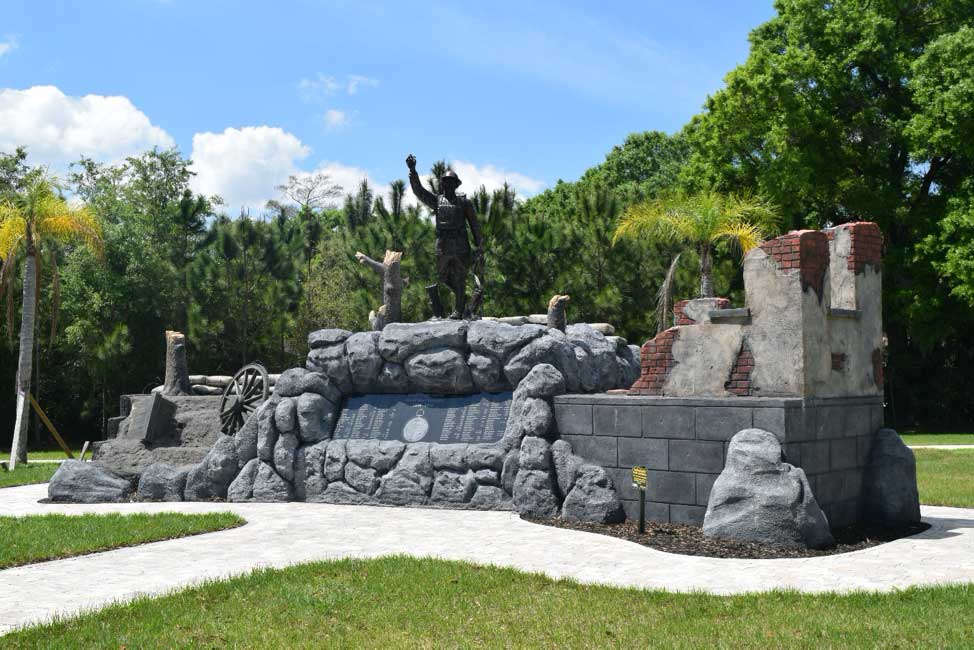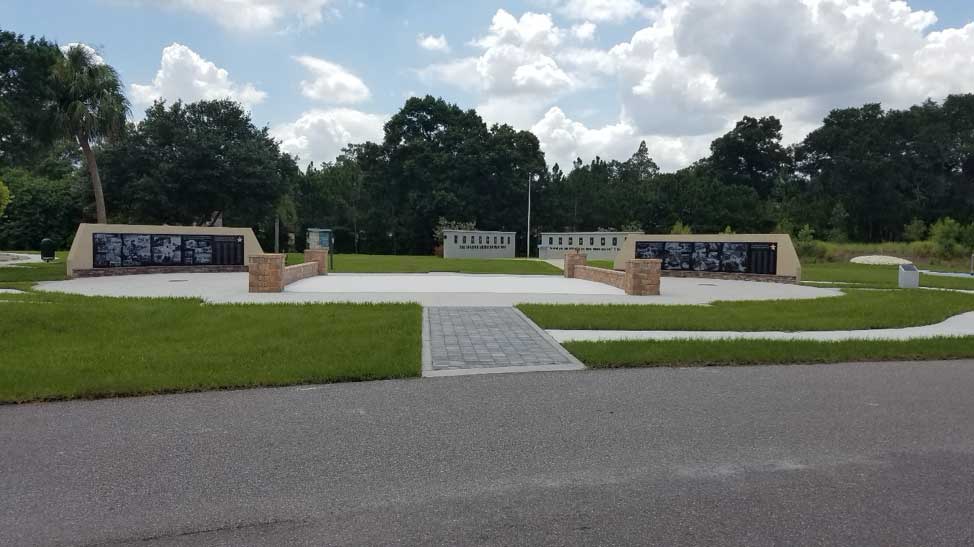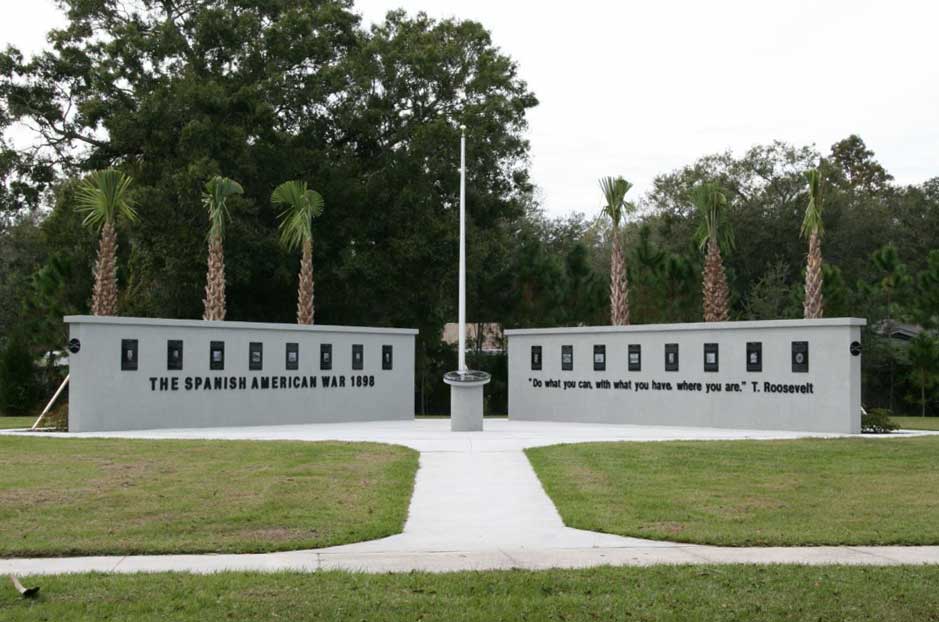


The War in Afghanistan (or the U.S. War in Afghanistan), code named Operation Enduring Freedom (2001–2014) and Operation Freedom’s Sentinel (2015–present), followed the United States invasion of Afghanistan of October 7, 2001 when the U.S. and allies successfully drove out the Taliban from power in order to dismantle al-Qaeda and to deny it a safe base of operations in Afghanistan.
Since the initial objectives were completed, a coalition of over 40 countries (including all NATO members) formed a security mission in the country. The war has since mostly involved U.S. and allied Afghan government troops battling Taliban insurgents. The War in Afghanistan is the longest war in U.S. history, having overtaken the U.S. participation in the Vietnam War in 2010.

(Below remarks are exerts from Tampa Bay Times article written by Howard Altman)
The Afghanistan Memorial is dedicated to the 16 residents of Hillsborough County plus 136 from elsewhere in the state who lost their lives during Operation Enduring Freedom, the nations longest war. On Saturday, October 7, 2016 years of hard work came to fruition when the memorial was unveiled. The date marks the 16th anniversary since the war in Afghanistan was launched. The memorial became personal for Mike and Annette Kirk, who led the Afghanistan Memorial Team because their son Paul, who graduated from Armwood High School in 2005, was killed in 2010 while serving in Afghanistan during Operation Enduring Freedom. Army General Joseph Votel, head of U.S. Central Command, and Scott Bill, father of Brian Bill, a Navy SEAL killed in the worst one-day disaster in U.S. Operations Forces history, were the keynote speakers at the Dedication ceremony.


View the YouTube video of the ceremony:
Dedication on December 14, 2013
2003-2011

The Iraq War, also known as the Second Gulf War, was a protracted armed conflict began in 2001 with the invasion of Iraq by a United States-led coalition that overthrew the government of Saddam Hussein. The conflict continued for much o the next decade as an insurgency emerged to oppose the forces and the post-invasion Iraqi government. An estimated 11,000 to 600,000 or more Iraqis were killed in the first three to four years of conflict. The U.S. became re0involved in 2014 at the head of a new coalition; the insurgency and many dimensions of the civil armed conflict continue. The invasion occurred under the pretest of a declared was against international terrorism and its sponsors under the administration of US President George W. Bush following the September 11, 2001 terror attacks.
The invasion began on March 20, 2003, with the U.S., joined by the United Kingdom and several coalition allies, launching a (shock and awe) bombing campaign. Iraqi forces were quickly overwhelmed as U.S. forces swept through the country. The invasion led to the collapse of the Baathist government; President Hussein was captured during Operation Red Dawn in December of that same year and executed by a military court here years later. However, the power vacuum following Saddams demise and the mismanagement of the occupation led to widespread sectarian violence between Shias and Sunnis, as well as a lengthy insurgency against U.S. and coalition forces. Many violent insurgent groups were supported by Iran and Al-Qaeda in Iraq. The United States responded with a troop surge in 2007. The winding down of U.S. involvement in the Iraq accelerated under President Barrack Obama. The U.S. formally withdrew all combat troops from Iraq by December 2011.


View the YouTube video of the ceremony:
Dedicated on February 27, 2015
August 2, 1990 – February 28, 1991

Memorial Team Leader: Annette & Mike Kirk
Memorial Team Members: Bob Silmser.
Below remarks provided by Wikipedia:
The Gulf War began with the Iraqi invasion of Kuwait on 2 August 1990 and ended with the Liberation of Kuwait by Coalition forces. Iraq subsequently agreed to the United Nations’ demands on 28 February 1991. The war officially concluded with the signing of the armistice on 11 April 1991. Major events in the aftermath include anti-Saddam Hussein uprisings in Iraq, massacres against the Kurds by the regime, Iraq formally recognizing the sovereignty of Kuwait in 1994, and eventually ending its cooperation with the United Nations Special Commission in 1998.
Assuming command of United States Central Command in 1988 General Schwarzkopf was called on to respond to the invasion of Kuwait in 1990 by the forces of Iraq under Saddam Hussein. Initially tasked with defending Saudi Arabia from Iraqi aggression, Schwarzkopf’s command eventually grew to an international force of over 750,000 troops. After diplomatic relations broke down, he planned and led Operation Desert Storm—an extended air campaign followed by a highly successful 100-hour ground offensive—which destroyed the Iraqi Army and liberated Kuwait in early 1991. Highly regarded for these exploits, Schwarzkopf became a national hero and was presented with many military honors for what historians termed one of the most successful campaigns in U.S. military history.
Schwarzkopf retired shortly after the end of the war and undertook a number of philanthropic ventures, only occasionally stepping into the political spotlight before his death from complications of pneumonia in late 2012. Leaving a legacy as a hard-driving military commander with a strong temper, Schwarzkopf was nonetheless considered an exceptional leader by biographers and was noted for his abilities as a military diplomat and in dealing with the press.

VIETNAM MEMORIAL – November 11, 2011
Remarks provided by Bob Silmser
A Sub-Committee was formed in August 2009 to design and raise funds to have this Memorial built. It was the first Memorial built for a specific theater of war. The County agreed to match whatever we raised for this Memorial and to date, January 1, 2016 $95,000 dollars has been raised. This Memorial was dedicated on November 11, 2011 in a ceremony that was attended by three different TV networks and hundred’s of people from all over the state of Florida.
When Jim Basta passed the Memorial was dedicated to his memory. We also included a reproduction of the Women’s memorial in Washington, DC, in black granite to honor all our Women Veterans. We had to obtain permission from the designer and the Memorial as well. We are very proud to display this in the Vietnam Theater of War.
With-in this memorial are two Helicopters which the Vietnam Helicopter Pilots Association of Florida procured and then repaired, painted and donated to Hillsborough County Veterans Memorial Park. Each of these Helicopters spent some time in Vietnam. The Huey came from Fort Knox and the Cobra from Camp Drum, NY 10th Mtn Division.
July 27, 2013 (Original Dedication – W/O Bronze Statues)
Final Dedication with Bronze Statues on January 23, 2016
June 25, 1950 – July 27, 1953
Remarks by Unknown
The Journey to the completion of this Korean War Monument began in 1999 when the Korean War Veterans Lt. Baldomero Lopez Medal of Honor Chapter 175 received its charter. Since then it has sought to build a monument for its namesake.
The beginning effort was dedicated on November 12, 2001 at Ed Radice Park in Tampa.
This was a joint effort by KWVA Chapter 175, American Legion Post 147 and Hillsborough County.
The monument consisted of an assembly of three flag poles with the center 35 foot pole displaying the US colors with two adjacent 30 foot poles, flying the Florida State flag and the Prisoner of War/Missing in Action (POW/MIA) flag.
At the base of each flag-pole were bronze dedicatory plaques: honoring (1) the US sons and daughters who stopped the spread of Communism: June 25, 1950 to July 27, 1953; (2) Florida patriots who sacrificed their lives serving in Korea so freedom would prevail.
1950 to 1953, and (3) the prisoners of war, missing in Action troops who served during the Korean War, 1950 to 1953.
On November 11, 2007, the second effort was dedicated at the Korean War Memorial in Ed Radice Park. Added to the Memorial was a 4 x 8 foot granite plaque featuring a biography of Lt. Lopez, his photograph scaling the seawall a Incheon, and a large rock from the Incheon seawall embossed and signed by the Mayor of Incheon.
On July 26, 2014, the third effort was dedicated at the new Korean War Memorial in the Hillsborough County Veterans Memorial Park. Hillsborough County donated $100,000 to construct the beautiful new memorial that features a granite edifice with a map of Korea and the names of Hillsborough County military personnel who perished there during the war. The Lt. Lopez 4 x 8 foot granite plaque with the Incheon seawall rock was moved to the new memorial and properly installed and walls were constructed where individual memorial plaques can be donated.
January 23rd, 2016, marks the fourth rededication of the Korean War memorial through the unveiling of three statues that were not available for the 2014 event. The three statues are: (1) a Korean woman with children who is contemplating those who made the supreme sacrifice, (2) The American Combat Soldier emblematic of Lt. Lopez, and (3) General Douglas MacArthur whose genius in devising the US invasion at Incheon turned the tide of the war.


WORLD WAR I MEMORIAL Dedicated – May 7, 2016
Remarks below provided by Bob Silmser
Many hours of research went into this Memorial. Artist Tim Lawn, an Army Illustrator, designed the Memorial to make it resemble battlefield of WWI displaying bombed out buildings and trees that were destroyed as well as a bombed out Military wagon. The Doughboy is climbing out of his trench and charging the enemy.
All the names on the large granite plaques are Veterans from Hillsborough County, who were KIA during this war.
Below remarks provided from Wikipedia
World War I, also known as the First World War or the Great War, was a global war originating in Europe that lasted from 28 July 1914 to 11 November 1918. Contemporaneously described as “the war to end all wars“, it led to the mobilization of more than 70 million military, including 60 million Europeans, making it one of the largest wars in history. It is also one of the deadliest conflicts in history with an estimated nine million combatants and seven million civilian deaths as a direct result of the war, while resulting genocides and the1918 influenza pandemic caused nother 50 to 100 million deaths worldwide.


Dedicated on December 7, 2017
September 1, 1919 – September 2, 1945
The United States’ efforts during World War II drew heavily on both the people and resources of the state of Florida.
Over 250,000 Floridians volunteered or were drafted into the armed forces. Dozens of military bases were established or expanded in the state and personnel flooded into Florida by the thousands. Many soldiers, sailors, marines, and airmen who trained or served in Florida later returned to the state as retirees and helped fuel the postwar economic boom.
Memorial Team Leader: Dave Braun Memorial Team Members: Leonard Black, Bob Silmser, Marty Sullivan,
Watch the dedication ceremony:



Dedication February 1, 2014
Rough Riders Rededication May 16, 2015
Apr 21, 1898 – Aug 13, 1898
Below remarks provided by Florida Memory State Library & Archives of Florida.
In 1898, national attention focused on Florida as the Spanish-American War began.
Florida was only 90 miles from the island of Cuba and was home to a large Cuban immigrant population. Cuban-Americans in Florida raised money and awareness in support of the war, and United States troops gathered in port cities around Florida.
The port city of Tampa served as the primary staging area for the United States troops bound for the war in Cuba.
The arrival of over 30,000 troops, including Lieutenant Colonel Theodore Roosevelt and his Rough Riders cavalry unit, changed Tampa from a small town into a city. Memorial Team Leader: Hal Youmans Memorial Team Members: John Werner

Dedicated on: October 20, 2018.
April 12, 1861- April 9, 1865
Florida joined the Confederate States of America in advance of the Civil War, as the third of the original seven states to secede from the Union, following Lincoln’s 1860 election. With the smallest population, nearly half of them slaves, Florida only sent 15,000 troops to the Confederate States Army. Its chief importance was in food-supply to the south and support for blockade-runners along its long coastline full of inlets that were hard to patrol.
At the outbreak of war, the Confederates seized many United States facilities in the state, though the Union retained control of Key West, Fort Jefferson and Fort Pickens throughout the war. There was little fighting in Florida, the only major conflict being the Battle of Olustee near Lake City in February 1864. However, wartime conditions made it easier for slaves to escape, and many of them became useful informers to Union commanders. As southern morale suffered, deserters from both sides took refuge in Florida, often attacking Confederate units and looting farms. In May 1865, Federal control was re-established, slavery abolished, and the state governor John Milton committed suicide by gunshot.
Memorial Team: Bob Silmser and Arty Sullivan


Dedicated on February 1, 2014
Below remarks provided by Bob Silmser.
When the federal government requested that Florida provide one battalion of five companies for service in the Mexican War, Florida responded by creating companies under the commands of Captains Robert G. Livingston, William W.J. Kelly, Henry E.W. Clark, Allen G. Johnson, and William Fisher. The units were raised in a unique method: these commanders recruited volunteers from the militiamen of their home areas.
Memorial Team Leader: Bob Silmser

(1817-1858)
The Seminole Wars, also known as the Florida Wars, were three conflicts in Florida between the Seminole, a Native American tribe that formed in Florida in the early 18th century, and the United States Army.
Memorial Team Leader: Dave Braun
Memorial Team Members: Bob Silmser





